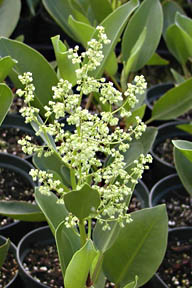
In the Garden![]()
Rick Barboza
Pawale species found
only on Big Island
Pawale
Rumex skottsbergii
Description: Unique, medium-sized shrubs grow 3 to 5 feet tall, with bright red stems and thick leaves that are usually flat and elliptical. Each leaf has a yellow midrib that contrasts with its foliage and red stems. The petioles, which connect the leaf to the stem, are also red with green streaks. When in bloom, a large inflorescence of greenish-yellow flowers protrude above the plant. Once pollinated, paper-like seed pods develop. They resemble, but are smaller than, those of ea'ali'i (Dodonea viscosa).

|
Cultural uses: Although not commonly used, likely due to the plant's scarcity, the bright greenish-yellow flower clusters and seed pods look great in lei. This is one of those flowers that will make people say: "Aunty (or Uncle), what kine flower is dat in your lei? Unreal la dat!" When you say: "Yeah, I know. It's pawale," you'll hear, "Pa-- what?"
You say: "PAWALE, you know Rumex skottsbergii!?" and enjoy the blank look you get in return.
Landscape use and care: This plant is naturally found on lava fields so you'll want to plant it in the sunniest location of your garden. Although it will handle partial shade, it will look best in full sun. It also likes well-drained soil that is not too wet. If you have well-drained soil, daily watering is OK, but a good soaking every two to three days is best. Few pests bother this plant, with the exception of slugs that may chomp on new shoots.
This is a really nice looking plant and it is now available at The Home Depot for about $5. I've never seen it on the retail shelves before, but I'm sure that once people see it, it won't last long.
More information: Of the seven species of Rumex found in Hawaii, three are endemic and they are believed to be derived from a single common ancestor; the other four species are recent introductions. Determining which of the three endemic species evolved first is difficult. They could have all radiated at around the same time from their original pioneer ancestor, or they could have shifted from one species to another. I guess only the plants know.

